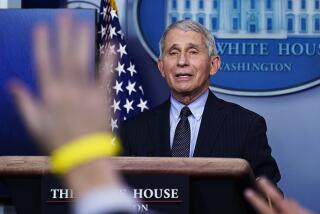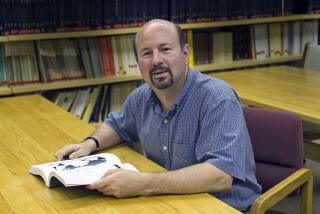UCI TAKES PRIZES : Rowland’s Road Was a Rocky One : Wednesday’s winner heard little praise among the roar of criticism 20 years ago when he first sounded the alarm over the dangers of commonly used chlorofluorocarbons.
- Share via
IRVINE — He is the sort of man people can’t help but like.
Crinkly smile. Crackly voice. Long white sideburns shaped like Florida.
He is a former semi-professional baseball player with hands the size of oven mitts, an erudite opera lover who shyly goes about shattering that age-old stereotype of the geeky chemist.
No gravy-stained neckties and wrinkled Goodwill shirts for 68-year-old F. Sherwood (Sherry) Rowland. More than a distinguished man of science, many said, he is a model of complexity, wit and style.
Hours after the Royal Swedish Academy of Sciences conferred upon Rowland the Nobel Prize in chemistry for his pioneering research into the depletion of the ozone layer, colleagues at UC Irvine could not heap praise upon him fast enough.
A magnet for talented young students, said chemistry department Chairman John Hemminger.
“The definition of class,” said fellow chemistry professor Larry Overman.
But 20 years ago, Rowland was frequently called a fraud.
Back in the 1970s, angry lawyers, ax-grinding politicians and panicky industrialists were comparing him to Henny Penny, the hysterical character from children’s literature who predicted the sky was falling.
Though he was racing to save the world, Rowland heard little praise at first above the din of outraged criticism.
More than a few scientists and politicians said he was an alarmist at best, an egotist at worst. They derided him for leaving his laboratory and playing the politician, for sounding the alarm but refusing to blend into the woodwork after discovering that common household products containing chlorofluorocarbons, or CFCs, were burning holes in the Earth’s thin protective ozone layer.
Scientists warn that ozone depletion will cause millions of cases of skin cancer and untold damage to human immune systems. Also, there may be climactic changes on a global scale that no one can predict.
Those who blamed Rowland for being too vocal about his dire findings later said he wasn’t vocal enough.
“I heard criticism at one point that what I should have done was what Rachel Carson did,” he said, referring to the pioneering author of “Silent Spring,” a landmark 1962 work that described the environmental dangers of pesticides.
Rowland said he didn’t know how to write a bestseller, so he did what he could--traveling the world, meeting scientists, cajoling world leaders.
As a direct result of Rowland’s peripatetic zeal, a worldwide ban on CFCs goes into effect next year.
In 20 years he has not slowed his pace. Just two months ago, he reported that Mexico City’s notorious smog is not caused by automobiles, but by household fuel tanks for stoves and heaters.
But before all this official acceptance and international acclaim--before the Nobel Prize, the Japan Prize, the Tyler World Prize in Environment and Energy, the Charles Dana Award for Pioneering Achievements in Health, and the Albert Einstein World Award--he was called a kook.
Rowland tries to downplay the heavy personal price he’s paid for refusing to hide among his beakers and test tubes, for tenaciously publicizing his discoveries.
But that price was painfully obvious in a touching moment Tuesday morning.
During a hastily arranged press conference at UCI--where he founded the chemistry department 31 years ago, and where he performed his earth-shaking research 22 years ago--reporters asked about the days when opponents outnumbered prizes.
First he was gracious:
“We come out of the blue saying we think there’s a danger associated with these chemicals whose commercial value each year was $2 billion, and we said, ‘We think you ought to quit manufacturing.’ It’s not real surprising that they didn’t say, ‘Oh, you’re right, we quit.’ ” Then he was magnanimous:
“Every time you find out something you think is publishable, it means that either somebody made a mistake early, or hadn’t thought about it. . . . And people who make errors don’t particularly like having you call attention to it.”
Then he glanced behind him at his wife of 43 years, Joan, and emotion suddenly overcame him.
Reaching for her, tears filling his eyes, Rowland managed a gruff whisper:
“Let me say, also, it helps very much to have people believe in what you’re doing.”
Smiling, Joan walked into her husband’s arms, and the couple savored an unscheduled moment of vindication, along with a disarmingly sweet kiss.
It was a long journey to credibility and official proclamation for the Rowlands, who met when he was an undergraduate at the University of Chicago. Theirs is an international adventure story, and a love story, that screenwriters as well as scientists might savor.
Years after his initial discovery about CFCs, which he published in the scientific journal Nature, Rowland was eventually validated by researchers who found hard evidence that a gaping, ever-widening hole appears above the Antarctic each October.
“When the Antarctic ozone hole appeared, it became apparent that [the ozone crisis] was more complicated than we had foreseen,” Rowland said Tuesday, “and that something very serious was happening.”
Asked what might have happened if the world had heeded his warning sooner and banned CFCs immediately, Rowland was understated but stern.
“I think we still would see the Antarctic ozone hole,” he said sadly, “but it would not be as deep as it was.”
Even without the confirmation of Antarctic researchers, Rowland told Joan from the start that his work could have staggering implications.
Tuesday, Joan recalled a particular time when Rowland hinted to her that he had unearthed a scientific horror.
Along with Mario Molina--his former research partner and co-winner of the Nobel Prize--Rowland had been logging long hours in his UCI laboratory, calculating and recalculating, she said.
One night in late 1973, he arrived home looking dejected and tired.
“How’s it going?” Joan asked, sitting up in bed.
“Very, very well,” he said. “It just means, I think, the end of the world.”
Later, the Rowlands went room-by-room through their house, rooting out every last aerosol can and pitching it into the trash.
Memories of that day came quickly to Joan Rowland’s mind Tuesday.
She smiled.
“I knew, of course, that once they’re produced, no matter what, [CFCs] are going to go back up,” she said, fluttering her hand to indicate the chemicals floating into the stratosphere.
Also, she and her husband knew that aerosol sprays accounted for only a portion of CFCs produced in the world.
“So throwing them out was really a symbolic act,” she conceded.
In the wake of an even more symbolic act--the winning of the Nobel Prize--she didn’t want to dwell too long in the past.
Surrounding her were longtime friends and adoring graduate students, each hoping for a moment with her husband, and each concerned with only one kind of chemical reaction:
The pressure that pops the cork from a champagne bottle.
As someone handed the winner’s wife a glass of wine, Rowland told her he was going upstairs to pose for photographs in his laboratory.
“I’ll be right back,” he said.
“Wait!” she said. “I’m going wherever you are.”
Turning to the many well-wishers trailing in her wake, she smiled. Then, taking her husband’s hand, the unofficial co-winner of the 1995 Nobel Prize for Chemistry could be heard to say:
“I know a good thing when I see one.”






